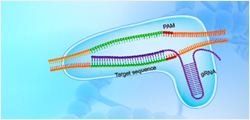SMPD1, His, Human
Sphingomyelin phosphodiesterase 1 (SMPD1) converts sphingomyelin into ceramide and phosphocholine; hence, loss of SMPD1 function causes abnormal accumulation of sphingomyelin in lysosomes, which results in the lipid-storage disorder Niemann-Pick disease (types A and B). SMPD1 activity is dependent on zinc, which is coordinated at the active site of the enzyme.
| ¥4100 | |
| Z05849-100 | |
|
|
|
|
|
|
|
|
|



































